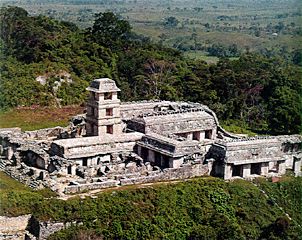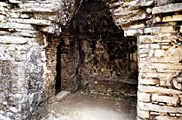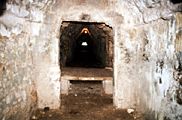
|
The Palace as we know it today is the result of much complex evolution. The earliest buildings of the complex are those referred to as the subterraneos. These early buildings consist of a group of united structures - three long parallel corridors.
The entire Palace complex was built upon a 3-meter high terrace. The early structures on this terrace were the subterraneos.
The open space between the two known subterranean structures was later filled in to form an upper terrace upon which were constructed the buildings which we now refer to as the Palace.


At the extreme northern end of the first Palace terrace further excavations by M in 1935 and Ruz in 1949 (Ruz 1952: 49-60) indicate that another building on the northern end was similar to the subterranean building on the southern end of the first terrace. This structure extended from east to west under the mainly collapsed building. In this early 2-corridor northern building the remains of a painted mural and stucco sculpture were found (Ruz 1958: 123). The collapse of House A-B was probably caused by the collapse of this earlier structure beneath it. The disintegration of this northern subsurface structure was probably due to the composition of the walls which were made of dirt rather than mortar.
Little is known of the other early subsurface buildings except that structures were found on this first terrace level in the Southeast Patio and on the western edge of the first terrace (personal communication, C, August 1980).
|